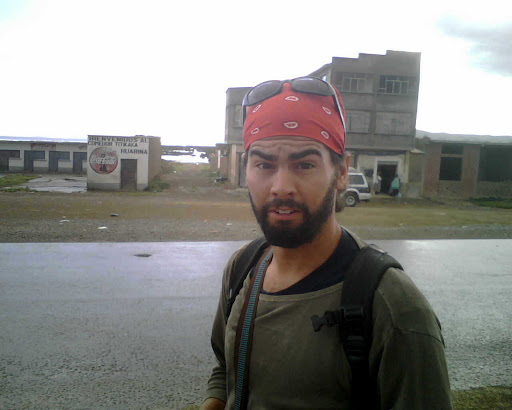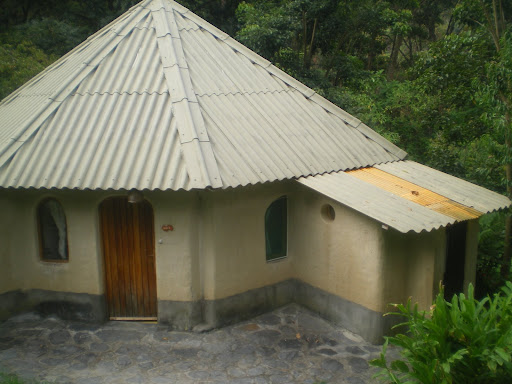7:35am – Sitting in our hotel on the Isla del Sol (Inti Marka). Watched the sunrise again, did some stretching, and tried to call Mia. We will be going back to Copacabana today, then to Sorata.
We packed up and headed out. We said goodbye to Elena (the French girl) and wished her safe travels.
9:24am – We had a nice little bread and coffee breakfast out on a patio and gave some Pringles to a little boy. There were two dogs playing and some donkeys kept humping. We walked back down the path we took up to the town (next to the little waterfall). We’re now sitting on a bench in the harbor waiting for a boat to come take us back to Copacabana. The water is crashing and it’s very peaceful. We’ve had great weather the whole trip so far. (See Ranz’s blog).
12:58pm – We are back in Copacabana. Our boat took about two hours and I finished reading Fargo Rock City. We just ate at our Hawaiian pizza place. So delicious. Ranz turned on the shower in the bathroom of the restaurant while trying to flush the toilet. We catch a bus at 3pm to Huarina, then to Sorata. We’ll probably lounge around town until we leave.
3:53pm – We’re on a bus from Copacabana. This is a real bus, like a Greyhound or Lakefront Lines for you Ohioans. They are playing Bolivian music overhead. Bolivian music is hard to describe. While there are a few varieties, this style uses some woodwind instrument accompanied by some opera-like singing. It almost sounds like traveling minstrels. It’s not very good.
We took the bus from Copacabana back to the ferry town. We got off at a halfway point between the ferry town and La Paz, a little town called Huarina. This place was hardly a stop on the map, and we were the only people in sight.

This was one of the points where our journey could potentially fall apart. There was a road heading out of town that went to Sorata, so we were hoping a bus would come along going to Sorata that would pick us up. Ranz called some travel number and the lady assured him that there was a bus on the way that we could jump on. We flagged a few vans down as they passed, but none were going to Sorata. On top of a somewhat desperate situation, it started to rain. We got under an awning up near a building, but every time a bus or van came into view on the horizon, Ranz would run to the road to try and flag it down if it was going to Sorata.
There was a town called Achacachi on the way to Sorata that some of the buses were going to, so we made up our mind that if we didn’t get a bus by 6:30 to Sorata, we would get a bus to Achacachi and try to get a bus to Sorata once we got there.
Just a little after 6pm our bus finally came rumbling into view. We flagged it down and hopped on with our bags. A Russian looking guy with really big eyes said to us, “How long were you waiting? You are lucky. This is the last bus!”
We were happy to be on our way to Sorata.
The ride to Sorata wound through the mountains on some roads that looked pretty perilous to me. I’m not going to lie, there were a few times when I was a little scared that the bus was going to go tumbling off the side of the road and down the mountainside.
This is probably a good time to describe the roads in Bolivia. In my mind there are four types of roads. 1) Paved roads. These are fairly close to what we have in America. Cement and asphalt. You find these in and around the large cities, like La Paz. There are also stretches of this type of road between some of the big cities. 2) Brick or stone roads. These are like cobblestone roads. I think of German village in Columbus. This is what the roads are in a lot of the smaller towns, except the stones and rocks are put down in a pretty random manner with kind of a that-will-do attitude. 3) Gravel and/or dirt roads. These are basically what they sound like. These are found outside the towns and connect the towns. There has been little or no effort to construct these roads; they just form out of use. They are generally flat and navigable, though usually not much wider than one lane. 4) Almost a road. These are the low-end gravel/dirt roads, but so extreme that they are hardly travelable. They are generally bumpy and pothole-infested. They may be more mud than dirt, have streams or creeks flowing through them, and are hardly one car-length wide. The route to Sorata took us on all 4 types of road, but in the mountains, we were generally on types 3 and 4.
Luckily, Ranz had some Dane Cook to listen to, which took my mind off the road. We arrived in Sorata around 8pm.
We got a taxi to our hotel, the Altai Oasis, which was a good fifteen minutes out of town. The taxi driver looked about 19, had a friend who looked maybe a year older, and his friend had a baby with him. There were also about four things hanging in the taxi from the ceiling and rearview mirror that were swinging all around as the driver took us down some muddy, bumpy roads. Strange.
9:32pm – From the bus in Copacabana, we got dropped off outside Huarina in the rain around 5pm. We waited until 6pm for a bus to Sorata and caught the last one of the day. The bus took us through the mountains and it got foggy then the sun went down. The bus rides today were actually busses.
We arrived in Sorata around 8pm and got a taxi to our hotel, the Altai Oasis. We got here (which is pretty far from the town, at least by taxi) a little after 8pm and put our bags down at the front desk and went to the restaurant, which closed at 8:30pm. We got hamburgers and brownies, which were both delicious.
We were then led down to our room by a worker. It’s like a little hut, but it has hot water and a private bathroom. It was nice to take a hot shower. Looks like we’re turning in now.
Oh. I forgot to mention how I went to the bathroom while our bus was being ferried and the lady at the bathroom window took my money and gave me my toilet paper and then I almost walked into the ladies restroom. Silly Ben.

No comments:
Post a Comment